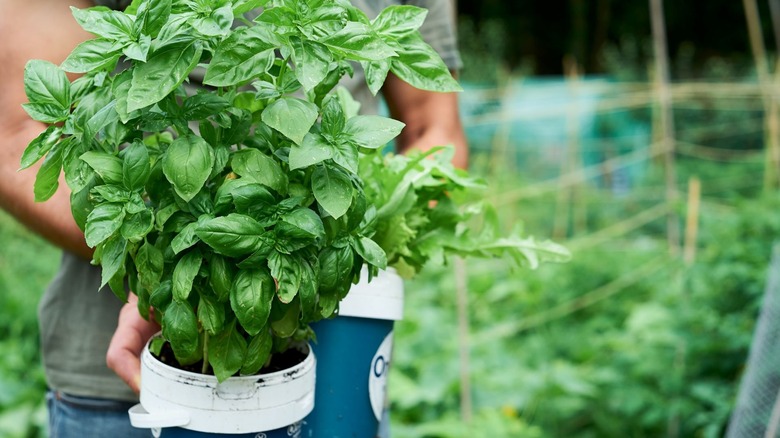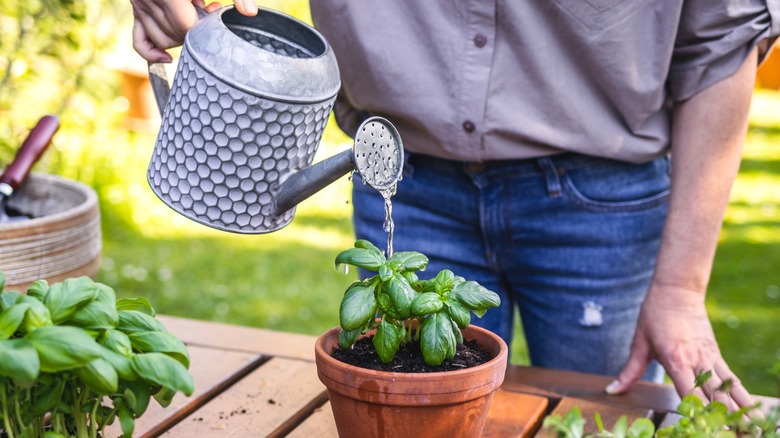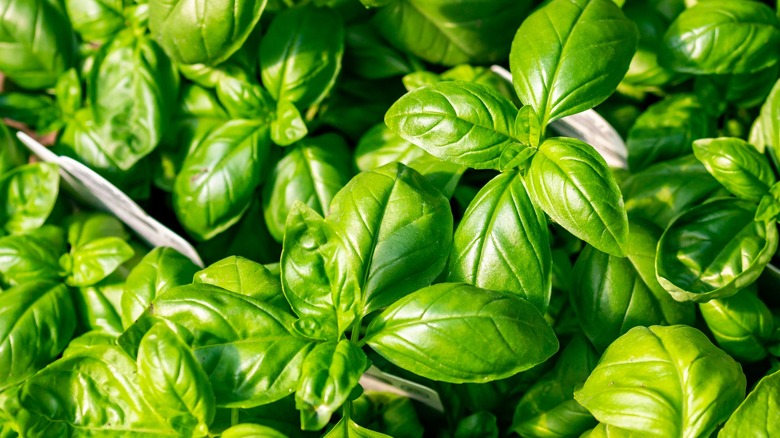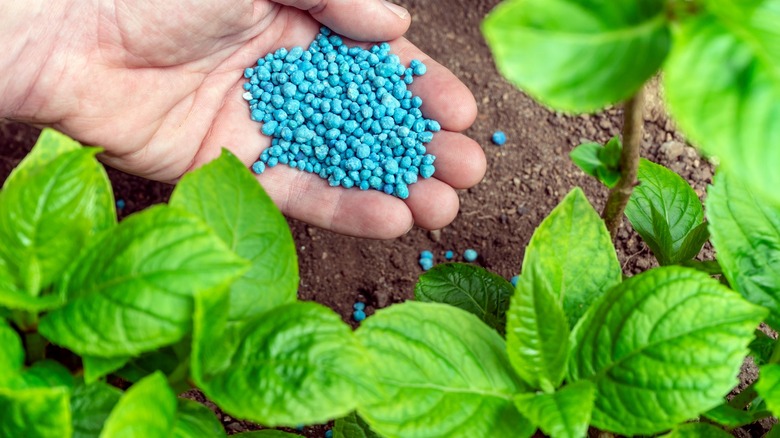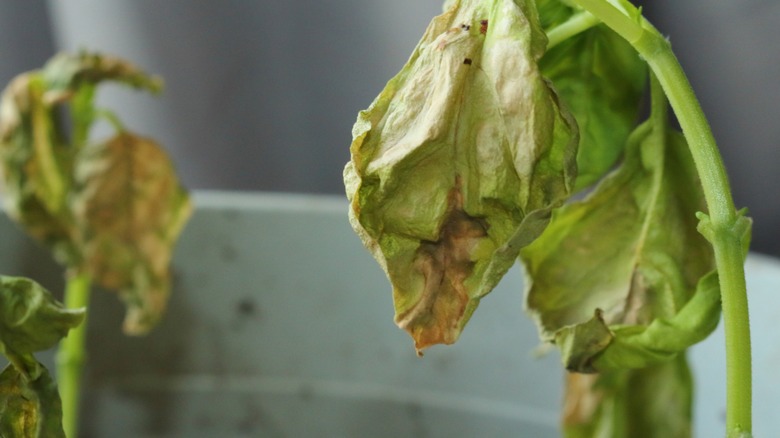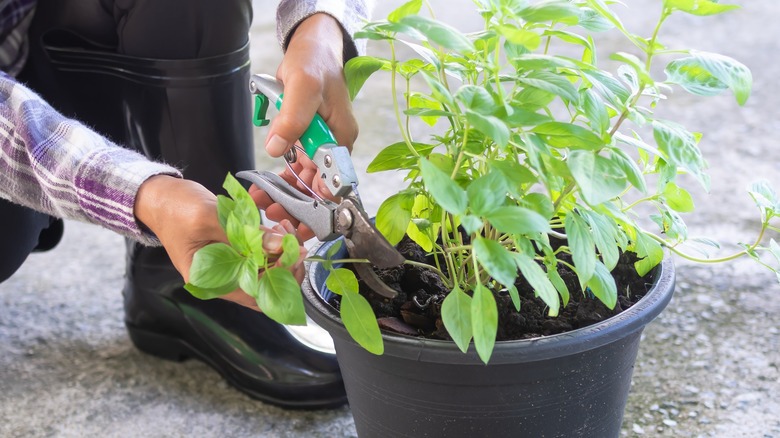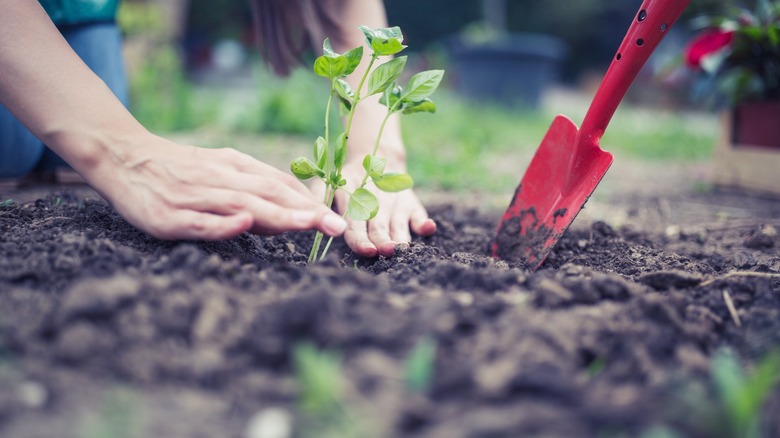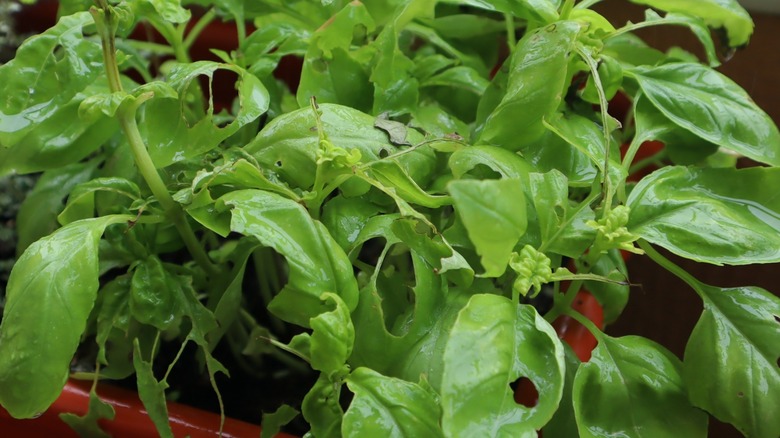7 Surefire Ways To Bring Your Dying Basil Plants Back To Life
Basil is one of the most popular herbs on the planet because of its aromatic leaves and sweet yet peppery flavor. It is usually a low-maintenance plant that requires little attention, but that doesn't mean it can't succumb to gardening mistakes. This is a real shame because these plants are attractive, and the leaves are a gourmet delight. Fortunately, when one is dying, there are surefire ways to bring it back to life.
This annual plant starts blooming in June and won't tolerate frost. Once the leaves are a deep green color, they can be taken off and used to flavor caprese salads, pesto, and other hearty dishes. There are quite a few varieties of basil, including Thai, Lemon, and Cinnamon — and all can exhibit similar growing pains. Basil can thrive in high temperatures, but things like high winds, the wrong amount of H20, and hungry insects can damage and kill it. Other culprits endanger these herbs, too, whether the basil is growing indoors or outside. If your basil plant is dying, here is how to save it from doom and give it new life.
Stop watering it so often
When basil is overwatered, the leaves start to turn yellow and droop. Other red flags include smelly soil and stunted growth. This is a common mistake; when it happens, the roots won't get the air they need, absorb the excess moisture, and become darkened and spongy. This is what root rot looks like. While the plant likes to stay consistently moist, it doesn't want to be sopping wet all week long. If you think yours is overwatered, start the recovery process by removing the damaged leaves.
For outdoor basil planted in gardens, push any mulch away from the plants to promote aeration. Give the soil a few days to breathe, then feel it with your hands. The top 2 inches should be dry, with the dirt underneath slightly moist. If it's still soggy, poke holes in the ground and loosen the soil. As a last resort, dig up the basil plant and check the roots. Cut away dead parts with gardening shears and replant the basil in another part of the garden. To ensure you're not overwatering them, keep in mind that mature basil plants need about 2 1/2 gallons of water each week, slowly applied so the roots soak it in.
An overwatered potted plant can be saved by moving it to a sunnier window. Otherwise, it might need to be moved to another container. To avoid watering it multiple times a week, avoid using garden soil because it dries out faster. Instead, use one that has peat moss, which retains water. Plastic and ceramic planters also retain moisture better. Going forward, don't give potted basil more than 1 gallon of water per week, depending on its size.
Change its location for proper light and less wind
Basil plants prefer about six to eight hours of full sun in the morning, followed by afternoon shade. They will also grow in indirect light and by windows that let in some sunshine, but there may be fewer, smaller leaves. They don't like a lot of wind either, because their large leaves can take the brunt of it and die.
A sure sign of basil not getting adequate sun is stunted growth. The leaves will be smaller, and there won't be as many to harvest. Too much sun and heat also cause light-colored spots. Then, they lose moisture, turn brown, and fall away. Basil can survive in temperatures up to 90 degrees Fahrenheit and up to 12 hours of direct sunlight. It's time to relocate when the location is too dim, sweltering, or windy.
It's a delicate dance of finding where to place your basil. Indoor basil can be switched to sunny spots like kitchen windowsills if the leaves are growing small, but move it back a few inches from the glass pane if it looks like they're getting too much light and exhibiting burnt spots. Replant in-ground basil in locations that get late afternoon shade if they aren't getting a break from the rays, and do the opposite for ones getting too much shade. If you know a sweltering hot day is coming and it might burn your basil, wrap the leaves with wet paper towels and cover the plants with boxes for a day. That way, they will stay protected.
Add more nitrogen to the soil
These herb plants don't usually need to be fertilized, but nutrients in the soil can get washed away from watering. Ones growing in gardens can benefit from a liquid fertilizer application twice a year, and potted indoor basil can get a boost from diluted liquid fertilizer added to the soil about once a month. A high nitrogen fertilizer can save the plant's life, but if you'd rather not use that, amend the soil with well-decomposed manure or compost. When basil gets the nitrogen it needs, the green color returns as the leaves become more robust and healthy.
But even when basil is watered properly, and these products are used, the leaves can still turn yellow. That could be a symptom of too much nitrogen in the soil, and a testing kit can show if this is the case. You will also notice that the leaf stems become "leggy." That's when they grow with longer stems and fewer, poor-quality leaves. And not only that, whatever gets harvested won't taste as good. To remedy this, remove your basil from the pot, dust the remaining soil off its roots, and add fresh ground to the planter. Replant it in the clean soil, and lay off the fertilizer for a few weeks.
Give it more moisture
Consistently moist soil is key for healthy basil plants, and when it dries out, the leaves start to wilt and turn brown. If they're planted in the ground, giving them 2 1/2 gallons of water per week might not be enough when it hasn't rained for days or temperatures have been consistently high. Thirsty outdoor basil plants should be watered every one to three days when there is a heat wave. And don't be stingy when watering them; soak the ground well and check the plants the next day to see if they have perked up. The best time to do this is in the early morning before the sun is high up in the sky because it gives the plants more time to absorb the moisture before it evaporates. Sheltering the plants from the wind can also help the leaves from drying out.
Potted, parched basil can be brought back to life by moving it to a less sunny location and giving it enough water to drip out of the drainage holes. If you forgot to water it for some time, try bottom watering it by putting the planter into a tub of water. That way, the roots will drink until they're satiated. Replanting them in larger containers also works because they get access to more soil and the moisture it contains.
Prune it more often
When basil isn't pruned often enough, it can start to wilt. Overgrown plants that reach 8 or more inches high are less likely to thrive, but can be given a new chance at life through consistent prunings. Remove dead and wilted leaves regularly and prune the plants every two weeks during the growing season. This redirects the energy towards producing new, healthy leaves instead of maintaining older, discolored ones. It also opens things up and gives the lower leaves more sunlight.
But don't pluck random leaves because that doesn't do anything for the plant. Instead, cut off the top sections of the stems. Look for central ones, and then direct your eyes down to find lower sets of leaves that have two leaf buds. Cut those stems a ¼ inch above that new growth. Basil also produces flower buds towards the end of its growing season, which can also be removed to encourage more leaf growth. This can be done with your fingers or with snippers.
Make sure it's in well-draining soil
Certain kinds of soil retain moisture better than others, and without a well-draining kind, basil plants can die. Heavy clay soils are not what you want because they compact easily, preventing water from circulating. Compacted soils aren't good either, because the air pockets within have been flattened out.
Soils like these retain excess moisture and become oversaturated. Without enough oxygen, plant roots start to drown, and basil can develop deadly fungal diseases. There are a few ways to fix the problem for basil planted outside, and the first one is to aerate the soil with a rake or aeration machine, but that needs to be done regularly. Some gardeners install French drains, which gather and redirect water flow away from the garden with angled drain pipes built into gravel-filled ditches. Lastly, you can also avoid walking on the soil by the plants because the pressure will compact it and squeeze out the oxygen.
Potted basil plants should live in good-sized containers with drainage holes on the bottoms, because they allow the extra water to flow out into the trays placed beneath. Remember to dump the water out regularly and keep the tray clean not to oversaturate the roots.
Eliminate insects and pests
Nothing's more frustrating than seeing uninvited guests all over your basil plants, chomping away at the leaves, and causing other kinds of damage. These invaders come in different sizes, from snails and slugs down to tiny aphids. When they are present, the basil plant might have holes in the stems and leaves, shiny, sticky leaf surfaces, misshapen or eaten foliage, and skeletonized leaves.
To reduce these populations, keep the garden free of plant debris and weeds, and remove any visible insects and pests by hand. They can often be washed off with a jet of water from the hose, and aphids can be deterred by reflective mulch.
Skeletonized basil leaves are a sign of a Japanese Beetle infestation. While that might sound intimidating, it can be treated in a few ways. If there aren't that many, put on gardening gloves, pick them off, and put them in a bucket of water mixed with dish soap. Take this away from the plants and dispose of the beetles in a trash bag. Another option is to set up Japanese Beetle traps near the basil plants. These have scented bait that attracts these shiny insects, which then die and get caught in the attached bags. However, that can make for an unpleasant-looking setup so close to the plants, not to mention an icky cleanup. Insecticidal oils and soaps like canola oil and neem can also keep insects and pests like these under control.
